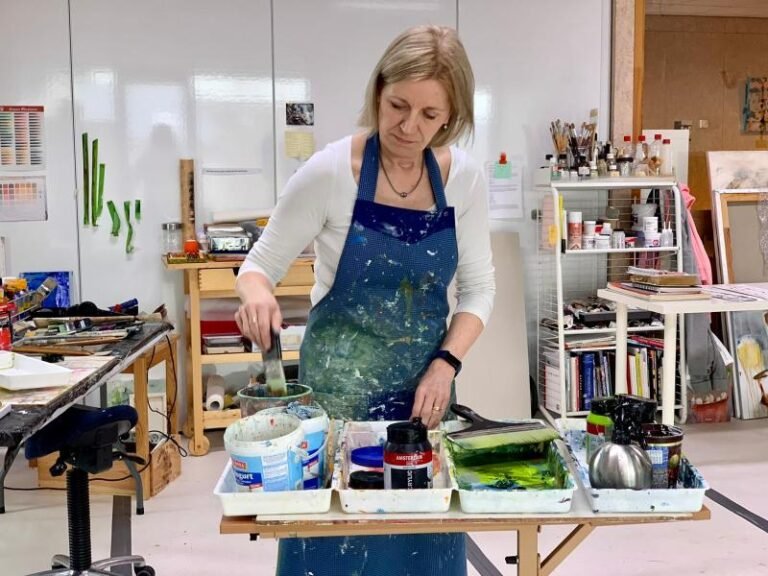What Do You Need for Oil Painting
Want to know what do you need for oil painting? Discover the 12 essential tools needed for a successful artistic venture. Our simple guide provides insights into the paints, brushes, palette, and more, ensuring you’re well-prepared for the vibrant world of oil painting.
Oil painting is a rich and time-honored artistic medium that has captivated artists for centuries. Its blendable texture and vibrant colors make it a favorite among creatives seeking to express themselves on canvas. If you’re new to the world of oil painting, getting started requires a set of essential materials.
What Do You Need for Oil Painting
In this guide, we’ll break down the fundamental tools every beginner should have to embark on a rewarding journey into the realm of oil painting.
1. Paints
The heart of any oil painting endeavor lies in the selection of paints. Oil paints come in tubes and offer a wide spectrum of colors. For beginners, starting with a basic set of colors is advisable, including primary colors and earth tones. As you advance, you can expand your palette to include a broader range of hues.
2. Brushes
A variety of brushes is indispensable for different techniques and details in oil painting. Flat brushes for broad strokes, round brushes for fine details, and filbert brushes for versatile application are some common types. Investing in a set of good-quality brushes will enhance your painting experience.
3. Palette
A palette serves as your mixing and blending space for colors. Wooden or plastic palettes are common choices, and some artists prefer disposable palettes for convenience. Experiment with different types to find what suits your workflow.
4. Palette Knife
Palette knives are versatile tools for mixing colors on the palette and applying paint to the canvas. They come in various shapes and sizes, allowing for both precision and expressive strokes. Incorporating a palette knife can add a dynamic element to your artwork.
5. Canvas or Painting Surface
Choosing the right surface is crucial. Canvas is a popular choice, and pre-stretched, primed canvases are convenient for beginners. However, you can also explore other surfaces like wood or paper based on your preferences and experimentation.
6. Easel
An easel provides a stable platform for your canvas or painting surface. Whether it’s a tabletop easel for convenience or a floor easel for a more traditional setup, having a reliable easel enhances your comfort and allows you to focus on your creative process.
7. Palette Cup and Palette Paper
A palette cup is essential for holding and cleaning your brushes between colors. Palette paper, on the other hand, is disposable and offers an easy way to mix colors without the need for extensive cleanup. These items contribute to a more organized and efficient painting session.
8. Mediums
Mediums are additives that can alter the texture, drying time, and transparency of your paint. Common mediums include linseed oil, turpentine, and gel mediums. Experimenting with different mediums allows you to discover the unique effects they bring to your artwork.
9. Rags or Paper Towels
Having a stash of rags or paper towels is practical for cleaning brushes, wiping off excess paint, and handling various tasks during your painting process. It keeps your workspace tidy and your brushes in optimal condition.
10. Varnish
To protect and enhance your finished masterpiece, applying varnish is essential. Varnishes come in glossy, satin, and matte finishes. Selecting the right varnish for your painting adds a professional touch and preserves its longevity.
11. Palette Sealable Container
If you use a palette with a lid, having a sealable container allows you to store your mixed colors for the next painting session. This helps minimize waste and ensures continuity in your work.
12. Apron or Old Clothing
Oil painting can be a messy affair. Wearing an apron or old clothing safeguards your wardrobe from accidental paint splatters, allowing you to fully immerse yourself in the creative process without worry.
Embarking on your oil painting journey is an exciting endeavor. By assembling these essential materials, you’ll be well-equipped to explore the boundless possibilities and express your creativity on canvas. As you gain experience, don’t hesitate to experiment with new tools and techniques to refine your unique artistic voice.
Key Takeaways (What Do You Need for Oil Painting)
- Oil paints in tubes for a wide range of colors
- Variety of brushes for different techniques (flat, round, filbert)
- A palette for mixing and blending colors
- Palette knife for precise and expressive strokes
- Canvas or painting surface, preferably pre-stretched and primed
- Easel for a stable platform (tabletop or floor)
- Palette cup for holding and cleaning brushes
- Palette paper for easy color mixing without extensive cleanup
- Mediums (linseed oil, turpentine, gel) to alter paint properties
- Rags or paper towels for cleaning brushes and maintaining workspace
- Varnish (glossy, satin, matte) for protection and enhancement
- Sealable container for storing mixed colors with a palette lid
- Apron or old clothing to protect from paint splatters





